Topic sharing: deep UV uvc-led
At present, the novel coronavirus is still continuing, which has a certain degree of impact on industry and enterprises, and also affects people's hearts in all walks of life. In this situation, under the guidance of the national semiconductor lighting engineering research and development and Industry Alliance and the third generation semiconductor industry technology innovation strategic alliance, China semiconductor lighting network and Jizhi headlines have started knowledge sharing during the epidemic period to help enterprises solve their doubts. Help our LED lighting enterprises and industries overcome difficulties together!
In this issue, we invited Hubei Shenzi science and Technology Co., Ltd. to share the wonderful theme of "the survey on the dose of deep ultraviolet killing new coronavirus" and the "naughty three thousand questions" of deep ultraviolet LED. The main contents are as follows:
1、 Does deep UV LED produce ozone?

1. How do ultraviolet rays produce ozone?
Theoretically, a chemical bond can be broken if the photon energy is higher than the bond energy. Therefore, ultraviolet light with wavelength shorter than 243 nm can stimulate oxygen in air or water to produce ozone. Uvc-leds with wavelengths higher than 243 nm do not produce ozone.
Low pressure mercury lamp will produce ozone, because the vapor pressure is between 1.3 and 13P, and there is naturally 185nm vacuum ultraviolet in the light spectrum of low pressure mercury lamp. This ultraviolet light will stimulate oxygen in the air to produce a combination reaction to ozone. In essence, ultraviolet rays break the oxygen oxygen covalent bond in oxygen molecules, and then combine with oxygen molecules to form O3. Uvc-led will not produce ozone, because the covalent bond energy of oxygen and oxygen is as high as 5.1ev, which requires ultraviolet light with wavelength at least shorter than 243nm to interrupt and finally generate ozone.
2. Why doesn't led produce ozone?
By controlling the vapor pressure, the low pressure mercury lamp can increase the energy level transition probability of short wave ultraviolet, but it will also be accompanied by other transitions, mainly at 254 nm and 185 nm. The first level transition probability of uvc-led is dominant, so the luminescence is pure. The wavelength of uvc-led is higher than 255 nm.
Low pressure mercury lamp is a kind of gas light source, and its excited state energy level position has been determined by mercury. Therefore, although there are high pressure, medium pressure and low pressure mercury lamp, the difference of vapor pressure is only to adjust the probability of transition between different excited states, that is, the relative intensity of different characteristic peaks. Therefore, the low-pressure mercury lamp mainly emits light at 254 nm and 185 nm. As an AlGaN semiconductor light-emitting diode with quantum well structure, the E0 transition is dominant, and the peak wavelength is only one, for example, 275nm. It can be found that the FWHM of the main peak of the deep ultraviolet LED is significantly lower than that of the blue light, which is also because the quantum well luminescence is more unitary than the electronic transition of multi size quantum dot light emitting devices. Because the emission wavelength of uvc-led is not lower than 243nm, the uvc-led for sterilization does not produce ozone.
2、 Can deep ultraviolet decompose formaldehyde?
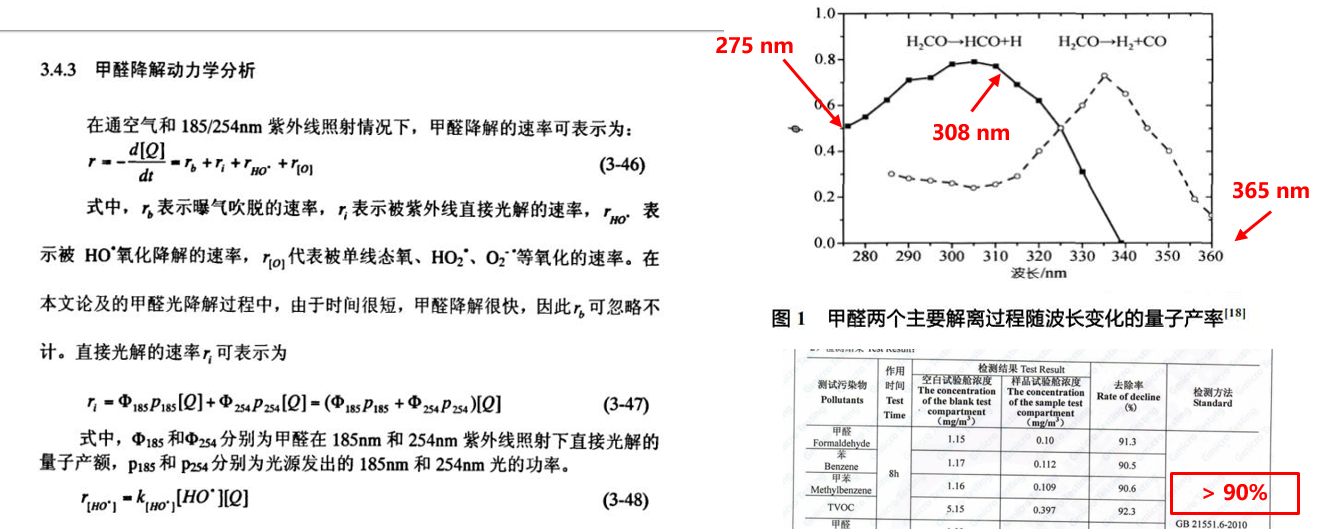
There are two kinetic processes in the decomposition of formaldehyde by UV: one is that the photolysis is interrupted by UV directly; the other is that the UV reacts with water in the air to produce OH radical to decompose formaldehyde. (mercury lamp tube is OK). Deep ultraviolet can directly decompose formaldehyde and other organic pollutants by breaking the chemical bond of formaldehyde.
Can deep ultraviolet ray decompose formaldehyde and other organic pollutants? In fact, many people think that it should not work, but in fact it can. The bond energy of O-O bond is 5.1ev corresponding to 243nm, but the necessary C-H bond energy in organic compounds is 4.31ev, corresponding to 283nm, C-O bond energy is 3.39ev, corresponding to 366nm. If the photon energy of ultraviolet is higher than the bond energy, it can be interrupted, just as it destroys DNA molecular chain. Therefore, UV can decompose formaldehyde.
However, we should also note that the decomposition process of formaldehyde is very complicated, and its two decomposition processes are directly related to the wavelength. The quantum yield changes of formaldehyde decomposition at different wavelengths. Although we don't know what two peaks are at 305 nm and 340 nm, there is no doubt that UV can decompose formaldehyde by itself. Compared with toluene and TVOC, UV can decompose.
3、 Does UVC deep ultraviolet ray have harm to human body, how to protect?
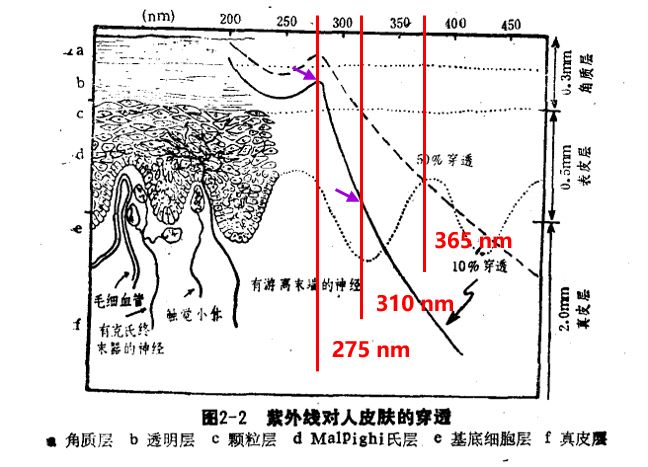
This is a classic problem, UVC deep UV is not harmful to human skin, but it is harmful to human eyes. About 97% of UV light at 275 nm wavelength of typical uvc-led will be absorbed by cuticle of human skin, more than 99.9% of UV light will be absorbed by cuticle and epidermis, and a small part of light will hit dermis. Ultraviolet rays only act on the dermis can cause skin cell canceration. Therefore, it is generally believed that UVC ultraviolet has little effect on human skin. Of course, baby skin, including some human skin cuticle is thinner, UVC ultraviolet resistance is also worse. The human eye has no cuticle protection. UVC ultraviolet radiation will cause lens and corneal lesions. Therefore, it is forbidden to look directly at the lighted uvc-led beads.
The shorter the wavelength of light, the worse the penetrability, which is determined by the wave particle duality of light. Of course, when it comes to matter, it's also about absorption. Does UVC deep ultraviolet have harm to human body? One of the easiest answers is, yes, don't be exposed to UVC. But in fact, there is a big misunderstanding, that is, UVA, such as 365, 385, 395, is very harmful to human skin, because this wavelength of ultraviolet can penetrate into the human dermis, causing skin cell cancer.
But UVC ultraviolet rays, such as 275nm, travel much shallower in the adult epidermis. After penetrating the stratum corneum, more than 97% of the energy will be absorbed, and finally the energy penetrating into the dermis is is not even 0.1%. Therefore, to be precise, UVC deep UV is not harmful to human skin, and eyes without stratum corneum are more dangerous. Of course, no matter how weak the long-term exposure to light on the human body is also harmful.
Therefore, do not blindly fear UVC deep ultraviolet, because the skin damage can be ignored in a short time; do not try to risk yourself, staring at the LED will definitely lead to eye injury.
4、 How to choose the window material for deep UV LED applications?
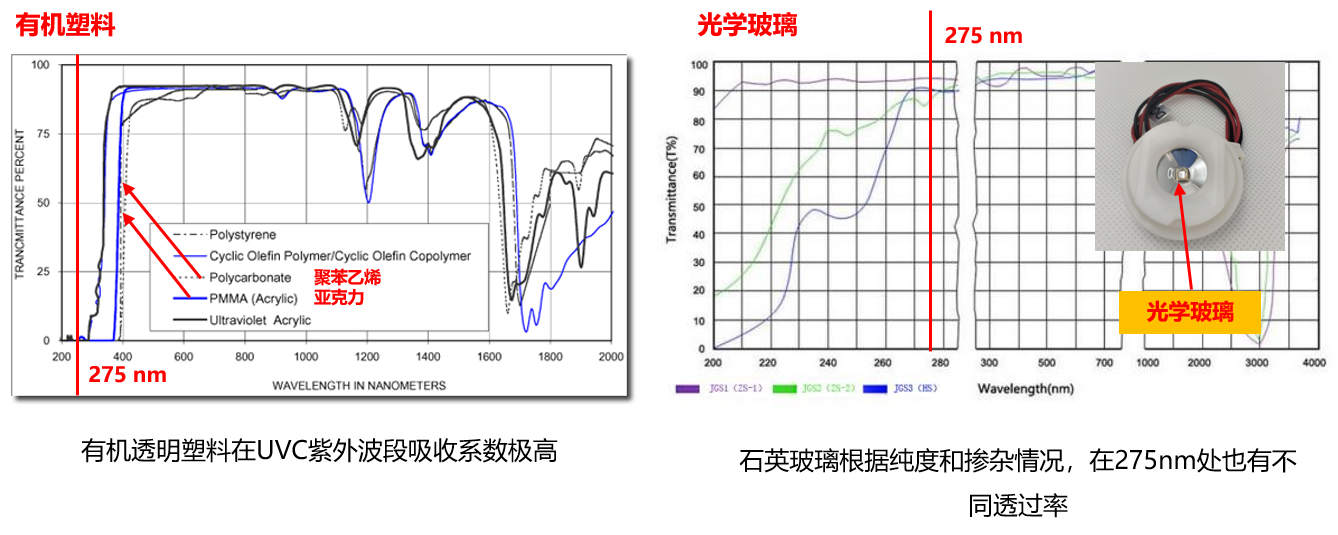
During the scheme design, the customer mistakenly thought that the transparent plastic such as acrylic, which is common in visible light scheme design, can also be used as the light window of uvc-led, and the sterilization effect is zero. This is not uncommon. Using the concept of bond energy, the absorption coefficients of C-H and C-O bonds in UVC and UVB are very high, so thin plastics can absorb almost all of the deep ultraviolet. The absorption edge of ordinary polystyrene and acrylic is about 385nm, and the transmittance at 275nm is equal to zero.
What kind of material should be used to make deep UV LED light window? Sapphire is the substrate of deep ultraviolet LED, and also the light surface of chip, so it can be used as light window, but the material and processing cost are high. There are many types of quartz, three common optical glass, jgs123. It is recommended that 275nm uvc-led can use jgs2 quartz, 265nm or even below led, JGS1 quartz or sapphire is required. This also applies to the lens material of lamp bead package.
5、 What is the effective irradiation distance of uvc-led?
The effective irradiation distance of deep UV uvc-led is not a fixed value, but depends on the light power, light transmission medium and the definition standard of "effective". Although there is no fixed value, the effective distance can be estimated according to the known information of the application scenario. At the distance of 1.22 meters, the killing time of 8.9 × 105 PFU / ml mers virus is 5 minutes.
Click to visit: dosage of commonly used ultraviolet sterilization
What is the effective irradiation distance of uvc-led? This is one of the most frequently asked questions. It would be a bit irresponsible to reply directly to a distance. A more reliable reply is to calculate the effective exposure distance according to the lethal dose corresponding to the indicated bacterial species concerned by customers, combined with the light power of LED lamp beads, the medium environment and the definition of "effective".
In order to let customers quickly and qualitatively understand the exposure distance of uvc-led, it is possible to estimate a value. For example, the effective distance to kill 8.9 × 105 PFU / ml mers virus in 5 minutes is 1.22 meters.
6、 Propagation distance of deep UV uvc-led in water?
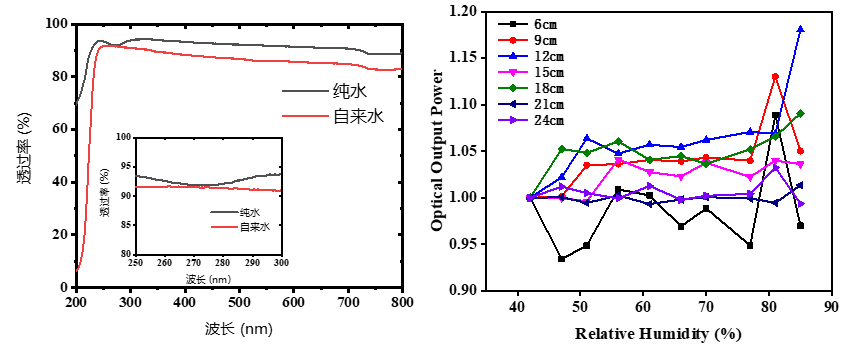
Both pure water and tap water have good transmission characteristics to the light with wavelengths between 250 and 800 nm. The transmittance of 5 mm thickness is more than 80%. When the wavelength is shorter than 250 nm, the optical absorptivity of both of them increases rapidly. In particular, tap water has a stronger absorption of & lt; 250 nm light. 2.4cm to 70%, 8.5cm to 30%, 16.3cm to 10%.
Based on the topic of effective distance, how far is the penetration distance of UVC ultraviolet in water? The bond energy of H-O bond in water molecule is 485kj / mol, corresponding to 4.98ev, which is about 249nm. Therefore, when testing the transmission spectrum of pure water, it is found that the absorption edge begins to decline at about 249nm. Based on this data, it can be said that the absorption of 275 nm uvc-led is not strong in normal drinking water with less impurities. The ultraviolet sterilization device based on UVC sterilization principle can kill a long distance.
The most important consideration is that the rapid divergence of light in the process of propagation leads to a sharp decrease in the far end intensity. In fact, hemispherical small angle packaging is very common in the UVA industry, which is also applicable to UVC packaging. Small angle light can make UVC spread further. It is very suitable for manufacturers such as water cup, long water tank and over flow water sterilization device.
High environmental humidity does not cause obvious absorption of UVC, which means that even in the sauna room, UVC ultraviolet can be used for real-time sterilization.
7、 Effective sterilization range of deep UV uvc-led?

When it comes to the effective sterilization range, it is also based on the concept of dose. Unfortunately, for a point light source, the intensity distribution of the illuminated surface of the plane is similar to the Gaussian distribution, and there can be several times the intensity difference at the center and the edge. If the customer is rigorous in asking this question, we should carry out more accurate optical simulation to calculate the intensity distribution in different parts of the plane. The simulation may not be accurate enough, but it provides a qualitative reference for our scheme design. The radiation surface is not uniform, and the simulation tool can calculate it clearly.
In defining the luminous angle of a lamp bead, the angle between half of the peak intensity is used. It is suggested that we should also define the position of half peak intensity on the plane as the effective range in the scheme design, and the dose calculation should also be based on the half height position.
Because LED light pattern is spherical like, the uniformity of intensity distribution is very different between near and far places. At 20 cm, the ratio of the effective irradiation area to the whole irradiated surface is larger.
8、 Is there a convenient test method to test the luminous angle of the lamp bead?
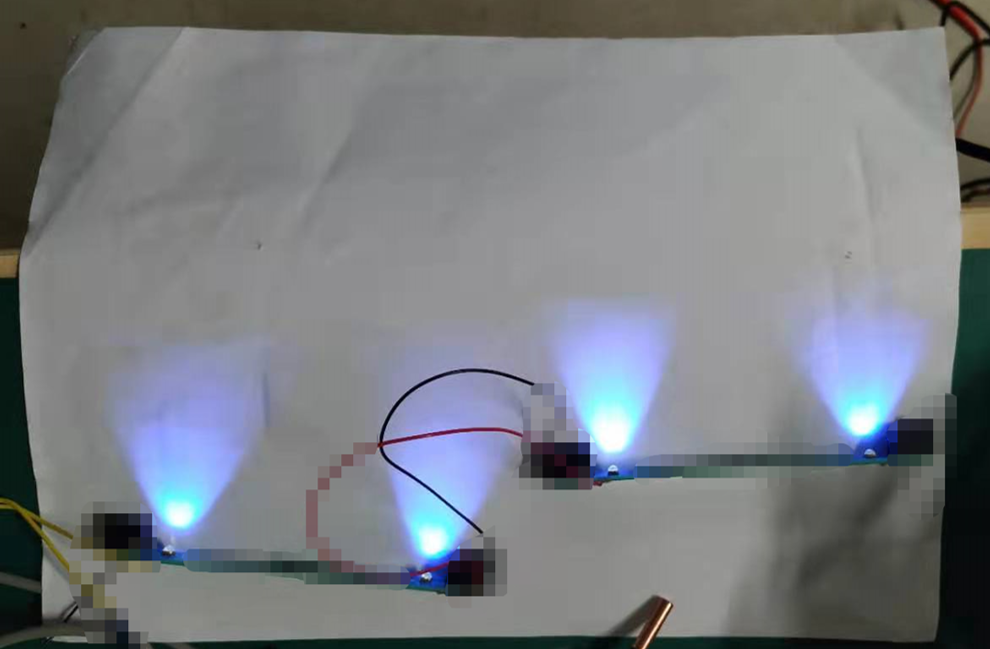
How to test the luminous angle quickly? In the laboratory environment, with the help of angle distribution tester, in the ordinary environment, we can use a simple method, that is, using the characteristics of white paper fluorescence response to ultraviolet light, the paper vertical lamp bead out of the smooth surface and center alignment. The angle of the blue and white area visible to the naked eye is the light angle. As shown in the following diagram, it is easy to see that the luminous angle of the dark purple hemispherical lens lamp bead is about 60 degrees.
9、 Is it necessary to drive with constant current IC? Is the resistance voltage sharing scheme OK?
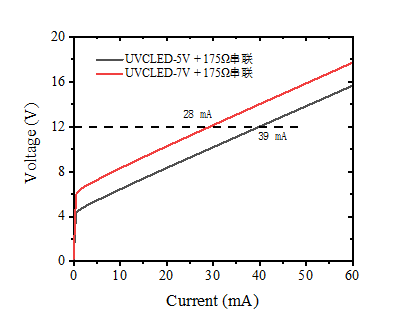
The nonlinear volt ampere characteristic of LED will amplify the difference of VF, which is reflected by the large fluctuation of current. If we insist on not using the constant current scheme, is it feasible? Yes, at least one resistor in series, and the resistance value of this resistor is particular. The nonlinear rectification characteristics of LED under forward bias voltage will amplify the difference of lamp bead VF, which is reflected in the current fluctuation. This fluctuation can be suppressed by series resistance. The IV curve after a resistor is connected in series is shown in the figure below. Its slope in the working range is smaller, so the current difference between them is smaller under the same voltage.
10、 DUVTek combat tools
Hubei DUVTek Co., Ltd., a pioneer of chip level deep UV LED UV sterilization technology, a professional supplier of deep UV UVC / uvb-led core "core" devices, self-produced epitaxy, chip and packaging, provides the world's leading deep UV LED lamp beads, PCBA module products and services for global deep UV LED solution providers and application manufacturers, and creates a rich industry with outstanding scientific and technological innovation ability The solution is to build an open and win-win product ecology, promote the construction of industrial norms, and help all walks of life of UV sterilization to realize the industrialization and upgrading of LED. Since 2008, after ten years of R & D accumulation, we have successfully achieved mass production of high-performance deep UV duv-led.
As early as 2008, under the leadership of Dr. Chen Changqing, the main technical team of deep violet technology was engaged in the research on the epitaxy, chip and packaging of deep ultraviolet LED in Wuhan National Research Center of Huazhong University of science and technology. In 2017, deep violet technology was established. In May 2018, the first 3MW deep UV LED product swc1s15a600 was launched for sale. Up to now, there have been more than 10 years of technical accumulation. The number of master and doctoral team members is more than 10. The reported WPE wall insertion efficiency laboratory level has reached 20.3%. Now we can achieve KK level capacity supply.
Deep UV uvc-led lamp beads are the most important business of deep UV technology. At present, we focus on the R & D and production of uvc-led at 270 ~ 280 nm. Sterilization and disinfection is the core and most important value of UVC. At present, we hope to focus on one event, that is, mass production of 275 nm uvc-led with small and medium light power. There is also a very important point, DUVTek does not do such components as static water sterilization module and all kinds of sterilization and disinfection applications. The company always firmly believes that the value of the company lies in the integration of internal skills.
1. Practical tools:[video tutorial] deep design of deep UV uvc-led sterilization scheme
2. Practical tools:Surface sterilization model
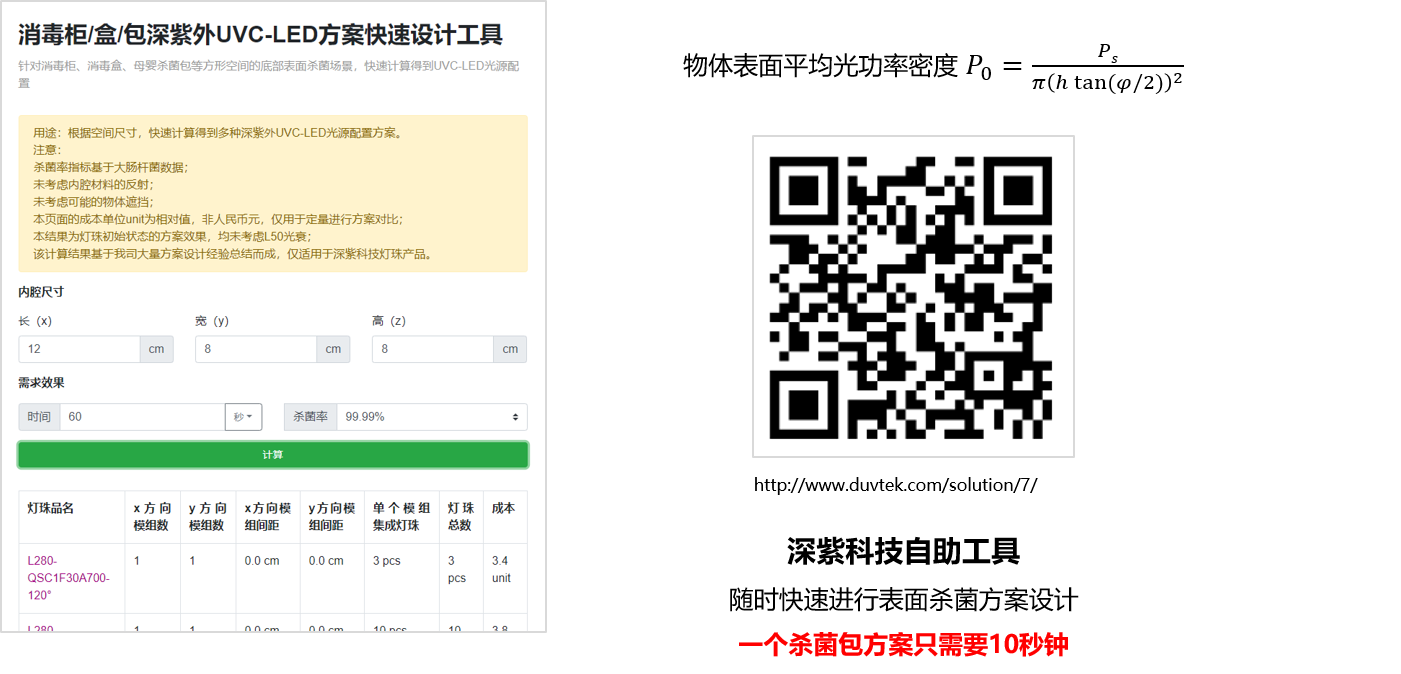
In a disinfection bag scene or a scene with clear length, width and height, it is convenient to calculate the light power density on the bottom surface according to the light power, and then calculate how long and how many lamp beads are needed according to the lethal dose of bacteria. The physical distribution of lamp beads can be calculated by using the concept of effective radiation range.
Conclusion: models will never be accurate, just as computers cannot calculate the future. But we can share data and methods together to make it a scientific tool for qualitative prediction. We also welcome colleagues in the industry to share more sterilization test data and revise the tool together to make it more accurate and mature. (there are more practical tools to continue to focus on DUVTek).
3. Practical tools:Air sterilization
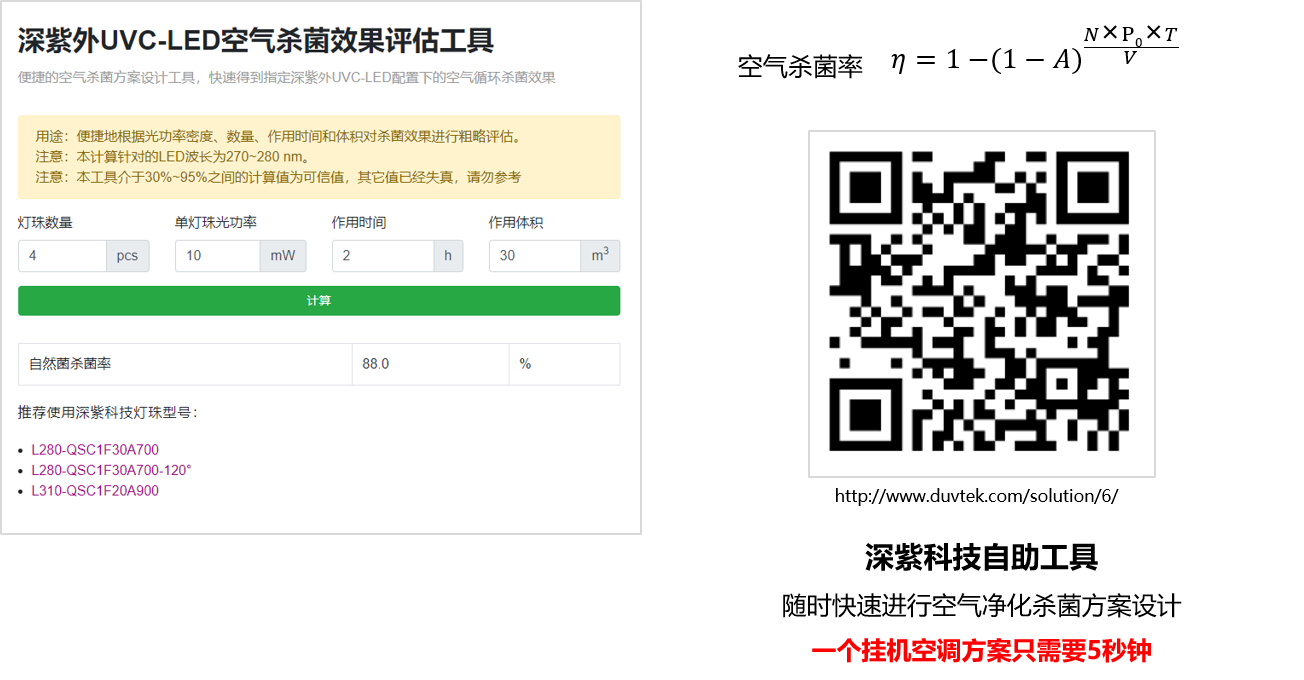
4. Practical tools:Endurance assessment
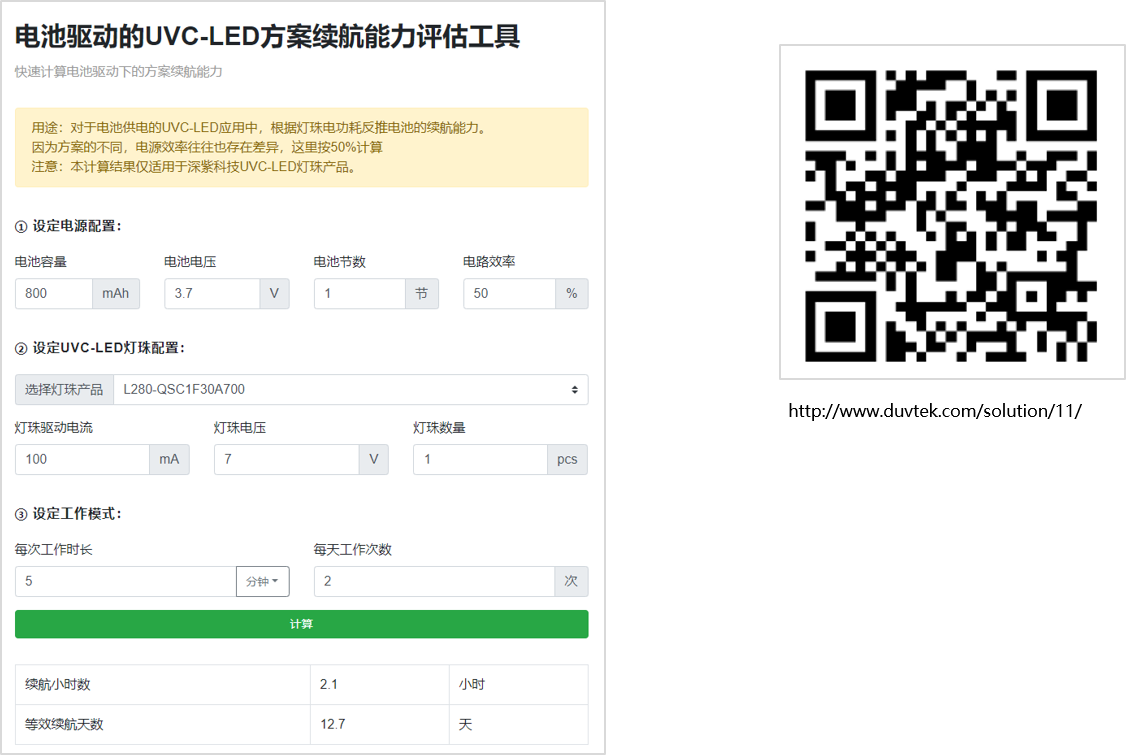
Eleven. Summary of novel coronavirus dose by UVC deep ultraviolet rays
Lethal dose is the basis of simulation, speculation and calculation of all UV disinfection schemes. Of course, there will be differences between the measured values and the theoretical values in the working conditions, and the theoretical model also has errors, but the theoretical values can provide reference for finalization.
The novel coronavirus novel coronavirus NCP with a TCID50 initial concentration of about 105.8 /mL has a 99.99% UV lethal dose of 1445 mJ/cm2, according to several domestic and foreign literature. The lethal dose of the new coronavirus dose is summarized. However, by multiplying the optical power density by time, Dr. Zhang Jianping of bolb pointed out an important detail, that is, the SARS test scene is an aqueous solution with a height of 1cm. It is not accurate to calculate the radiation dose of the whole solution with the surface strength.

The irradiation intensity is inversely proportional to the square of the distance, so the irradiation intensity at the bottom and top of the solution is not the same. If the cumulative dose is calculated, the linear average value should be taken; LED is a small flat light source, which is similar to the point light source, and the distribution of the irradiated surface is not uniform. However, considering the small fluctuation within 1cm range, the influence is not big, the approximate average value can be used here. The absorption of UVC by aqueous solution is less than that of pure water at 275nm, and the density of virus dispersion is also limited. The lethal dose is revised to 1085mj / cm2 without considering the absorption of water, and the lethal dose is corrected to 1085mj / cm2 after depth integration.
It should be noted that the experimental light source of "lethal dose & quot; comes from low-pressure mercury lamp, which is difficult to guide UVC led sterilization practice. The lethal dose for different wavelengths of UV is a problem that the whole industry is facing and needs to solve, rather than looking at the DNA absorption spectrum.
Finally, I would like to thank the national semiconductor lighting engineering R & D and Industry Alliance for guiding the live broadcast activities organized by China semiconductor lighting network and Jizhi headlines. DUVTek is a young company. We hope to become a valuable company to promote the development of the industry. We also welcome our colleagues to exchange and interact with each other to create a new era of uvc-led. The new epidemic in 2020 is just the beginning of a long-distance race. Let's witness the golden age of uvc-led together. Come on!
Q & a session
Q: in the development and design of deep UV LED related products, how to do a good job of prevention, what are the precautions?
A: Chen Jingwen: if it's self-protection, it needs to do: 1. Don't look directly at the lighted uvc-led; 2. If you have to look, don't stare at it; 3. If you have to stare, please wear resin glasses or goggles; 4. The skin doesn't need to pay attention to protection, and UVC ultraviolet rays can hardly penetrate the dermis. But if you pay attention to skin color, or wear clothes.
Q: has the company started to supply products or applications in batches to the market?
A: Chen Jingwen: deep UV technology aims to make deep UV LED lamp beads and simple PCBA modules instead of components and applications. We just want to improve our internal skills and integrate them, so that more partners can do professional module solutions and finished products. The product has achieved mass production, see:List of uvc-led lamp beads
Q: can the conditions of decomposing formaldehyde by UVC led be introduced in detail? Such as cabin size, UV C led wavelength, power or irradiation location, whether there are circulating air conditions?
A: Chen Jingwen: UVC is used to decompose formaldehyde with a single 12MW, wavelength of 278nm, and an experimental chamber of 1m3. The test standard is in accordance with the standard test process of Guangwei micro test. More than 90% of the samples were decomposed in 8 hours.
Q: are there any sapphire window products on the market at present, or are there any relevant information? Are most of the restrictions on their application cost?
A: Chen Jingwen: as far as I know, sapphire is not used as a light window in mainstream products on the market, but there are R & D products. The limiting factor is cost. Other problems can be solved by money.
Q: the ultraviolet radiation efficiency of UV-LED is only 3%, which is much lower than that of low-pressure mercury lamp. If you want to achieve the same radiation dose, the cost will be much higher. So from the perspective of cost performance, is UV-LED UV not suitable for sterilization in large space?
Chen Jingwen: Yes, but there are exceptions. It is still feasible to use the reduced led scheme to achieve the target sterilization effect when the sterilization time is not sensitive.
Zhang Hao: evaluation and application of UVA led photocatalysis technology for air sterilization and disinfection
Industry News · February 15, 2020 · 1992 views
Group company UVLEDTEK was selected as a national specialized and new "small giant" enterprise
Company News · August 16, 2022 · 535 views
Professor Chen Changqing, chairman of the board of deep violet technology, was invited to give the conference report "semiconductor UV LED and its application
Company News · December 29, 2017 · 1098 views
Ultra clean semiconductor plant of szech technology put into operation
Company News · February 10, 2018 · 2217 views
The air humidifier used by every family may be the culprit of pneumonia. How to avoid causing pneumonia
Industry News · January 6, 2020 · 442 views
Novel coronavirus UVC to be launched by us Airport
Industry News · January 31, 2020 · 658 views
[video tutorial] deep design of deep UV uvc-led sterilization scheme
Technical Sharing · February 11, 2020 · 1639 views
Application of UV-LED in sterilization and disinfection water purification
Technical Sharing · November 15, 2017 · 793 views
